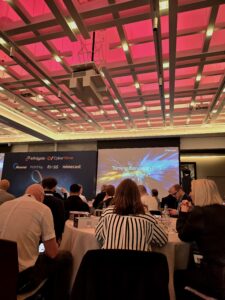Artificial intelligence is no longer a far-off idea; it is now here, affecting decisions, changing how we work, interact, and safeguard our digital environments. This reality came to life yesterday at Infinigate Cloud’s Cyberverse 2025, when buyers, sellers, and cybersecurity experts convened to debate one of the most important issues of our day: Is AI an opportunity, a threat, or both? Curiosity, creativity, and a hint of caution permeated the air, making it the ideal setting for a discussion about the developing relationship between cybersecurity and artificial intelligence.


The Question That Started the Conversation: Opportunity, Threat, or Both?
Attendees were asked if they saw AI as a threat, an opportunity, or both in an interesting poll that kicked off the event and established the tone for the day. The majority of individuals, predictably, selected both. The complicated reality we live in today was captured in just one question. On the one side, AI enhances decision-making, automates defences, and speeds up danger identification. However, it also creates new vulnerabilities, such as deepfakes, data poisoning, and autonomous attacks that change more quickly than we can react.In our digital age, AI is both a sword and a shield, as the audience’s response aptly illustrates.The Main Takeaway: Vulnerabilities Are Quality Problems
“Vulnerabilities are quality issues” was a bold but provocative remark that served as the event’s main topic. This concept changed the way we see system flaws. The speakers stressed that vulnerabilities are signs of more serious quality issues, such as those in design, development, or process oversight, rather than being seen as isolated defects. The conversation emphasised that proper construction, secure code, ongoing testing, and proactive risk assessments are the foundation of effective cybersecurity. Vulnerabilities cease to be afterthoughts and become avoidable design issues when quality is prioritised from the beginning.The Human-AI Balance: When Machines Learn Too Much
An analysis of Sundar Pichai’s perspective on AI, that it should enhance human endeavours rather than be entirely humane, was one of the day’s highlights. Meaningful discussions about striking a balance between machine intelligence and human intuition were spurred by this comment. Even though AI can digest data extremely quickly, it still lacks context, ethics, and emotional intelligence skills that only humans possess. The agreement? Human monitoring must continue to be crucial even as AI expands our capabilities. AI won’t take over in the future; instead, it will collaborate with people to outwit ever-changing cyberthreats.Seeing Through the Glass: The Fishtank Principle
The discussion of the Fishtank Principle, the notion that openness is the cornerstone of reliable systems, was another intriguing lesson learnt from Cyberverse 2025. Organisations must guarantee visibility into how AI functions, including what data it utilises, how it learns, and how it makes judgements, just the way a fish tank allows us to observe everything going on inside. This idea is particularly important in cybersecurity since “black box” AI systems can provide hidden dangers. In a world increasingly dominated by algorithms, transparency fosters responsibility, which fosters confidence.Beyond the Conversations: Networking in the AI Era
 Although the lectures were insightful, Cyberverse 2025 was a hub of relationships rather than merely a set of talks. Professionals, customers, and vendors discussed trends, exchanged ideas, and imagined security in the future. The networking events were vibrant and purposeful, demonstrating the value of human interaction even in the era of AI-driven communication. These times of cooperation and communication serve as a reminder that creativity flourishes when people’s viewpoints and thoughts come together.
Although the lectures were insightful, Cyberverse 2025 was a hub of relationships rather than merely a set of talks. Professionals, customers, and vendors discussed trends, exchanged ideas, and imagined security in the future. The networking events were vibrant and purposeful, demonstrating the value of human interaction even in the era of AI-driven communication. These times of cooperation and communication serve as a reminder that creativity flourishes when people’s viewpoints and thoughts come together. 